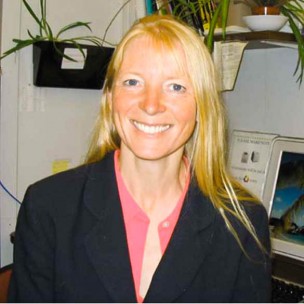
Visiting Assistant Professor of Biology Joyce Powzyk has been teaching at Wesleyan for 10 years and counting. Her fascination with animals especially primates and her enthusiasm for teaching are apparent not only on her office door, which features photographs of a lemur and an Indri monkey, but also in the eccentric topics of her biology classes. She sat down with The Argus to talk about animal sex, fieldwork in Madagascar, and illustrating children’s books.
The Argus: What are your favorite texts on your bookshelf?
Joyce Powzyk: I have to say that when it comes to my favorite textbook of all the courses, [it would be the one from] Biology of Sex, about sexual reproduction. It’s pretty flamboyant stuff. I love the book “Dr. Tatiana’s Sex Advice to All Creation” by Olivia Judson. She used to write a blog for The New York Times. She’s an evolutionary biologist. She presents biology by having animals, whether they be segmented worms or chimpanzees, “write” in to her saying, “I have a problem with my sex life. What can I do about it?” She answers these “Dear Abby” sex letters, and by doing so, she explains the whole field. She talks about the strategies that species employed. She compares and contrasts and she just illuminates our world. So hers is my favorite textbook.
I also love a book, which would be more for summer reading, by Robert Sapolsky: “A Primate’s Memoir.” It’s about his fieldwork in Kenya over 20 years of experience. He’s had everything happen to him possible, but he darts his baboons with a blowgun, he takes their blood, and he finds out how they work. He’s a neurobiologist who studies a lot of stress response. Brilliant, brilliant books.
A: How did you stumble upon these books?
JP: Oh, great story. “Dr. Tatiana’s Sex Advice to All Creation” was [recommended to me by] my bicycle mechanic who works at Pedal Power on Main Street in Middletown. He said, “Have you read this book?” I said, “Absolutely not!” He said, “It’s really good.” So I read it, and now it’s my textbook.
I found “A Primate’s Memoir” when I looked up Robert Sapolsky and his books. I saw that, and having done fieldwork myself—I lived two years in Madagascar—what happens to you during fieldwork is crazy stuff; you can’t expect it. I love reading about other people’s fieldwork experience, because the things we have to live through, whether it’s storms, or a disease that wipes out your animals, or carnivores come, or the government all of a sudden is a bit hostile where you’re working because it’s not the United States. He’s such a good writer and he talks about funny details; he talks about what it’s like to be a family man and trying to balance work and family, and it’s real, and I love it.
A: Speaking of fieldwork, have there been any extraordinary moments that you’ve had in the field?
JP: Working in any primate field study is going to be phenomenal, but also can be really scary. I worked in Madagascar, which is an African country, so you’re speaking French and you’re trying to tell your African guides what the work is and get them excited about the project. I lived with three men. They had their tent and I had my tent for two years. Doing my actual living in the field was a lot of work, but I loved getting to know Malagasy more personally than just being a traveler that passes through. It’s so different to live there.
There were some major cyclones that hit the island and they were life threatening. Trees are falling down all around you. My head guide picked my campsite because, unbeknownst to me, he had already looked to see if there were big trees that could come down, and he said, “This is the good place. This is base camp.” We did not have crashing limbs too much. They were near us but not on our tents; we survived.
The other thing that happened is that I hurt my knee just from hiking. One of my friends who was visiting said, “Joyce, if your knee doesn’t get better, I guess that just means your PhD is scratched, right?” I was like, “Yeah. Oh, I hadn’t really thought of it quite so bluntly.” Just the physicality of the work is something you don’t often worry about, but if you get an injury, it means you can’t collect data. Luckily, my knee got better.
I was tracking animals with a radio collar. So I had a receiver and I was listening to the sound of a beeping noise as the signal was emitted from the lemur’s collar. I was so busy listening to my beeps that I took a bad misstep. I played a lot of sports; I’m really comfortable with the physical stuff, but I realized I wasn’t paying attention. That knee injury could have been the end of it, but it wasn’t.
A: I noticed that you have written several books and actually have illustrated several publications. What has inspired you to combine art and science in this way?
JP: I find it really logical. When I got out of college, I had a zoology degree and I really didn’t know what I was going to do, and I was working various jobs to make money and did travel and saw animals in their wild setting. But I’ve always done art. I didn’t ever go to school for art, but I find science and art are conjoined at the hip. To me, when I understand something, I can draw it. I love anatomy. I love showing behavior through the posturing of an animal. So I was able to combine my interest in science and art to write books for children on natural history.
I traveled through Australia, for example, before graduate school, and I wrote a book about my travels through Australia called “Wallaby Creek” because I was so excited. I’d go home with all these raw field sketches and then I’d make up the formal paintings. I actually got a publisher on board. It was just intoxicating to think that you can write about science and travel. Some people will never go to Australia, but you can write a children’s book that makes it feel like they did. And again, I always love art; I love aesthetics. But if I can draw something, I know it really well. It sounds corny, but in a way, I had it in my mind, all those early biologists that used to travel with portfolios and sketch from life; I thought that was so darn romantic, you know? I had my portfolio and it was encased in Gore-Tex and I’d open it up and have my paintbrushes and everything. I just thought, “Wow, this is the real deal. The animals are there and I get to sketch them.”
A: You’re like the next Charles Darwin.
JP: Well yeah. I read about all of these people and I thought, “Well, why can’t I do that?” So I tried and it worked out pretty well. I did, I think, six children’s books, and then I also would illustrate other people’s books that I didn’t write. It was very fun. So that was kind of a mini career. Then I decided to go to graduate school, and I did illustrate some books in graduate school, but obviously the work is kind of all-consuming, so that slowed down. But I love thinking about painting, and I still paint and show, so that will always be a part of how I view science. It’s incorporated within my art.
A: Why did you decide to cater your work toward a younger audience with children’s books?
JP: Again, it sounds so basic, but I worry that kids are kind of getting separated from nature. I grew up in a landscape where we had some vacant farms around our house, and I would wander all the time and I’d collect stuff and bring it back to my house and draw it, and I worry that, with children growing up in places where they can’t wander and experience nature, there’s a disconnect. I want to make sure you catch kids at a young age. I think kids have a liking of animals and nature and something’s got to go wrong to break it, if they’re turned off by it or they have got too much else going on in their lives to think about other living things.
So I think catering to children is trying to cultivate that in a more aggressive manner. I don’t know if it’s true. But the kid who lives in a city who doesn’t have a big backyard like I did, so long as there are good books that can take him or her there, it’s a bit better. Get ’em while they’re young. They don’t have to go to Australia, but they should value all kinds of ecosystems. I think that with global change and global warming happening, we are not quite realizing how much of an effect we have, and we have to instill it in the younger generation because unfortunately, they are going to have a lot on their plate.
A: What do you hope to achieve now as a professor and a researcher?
JP: Well, I have a little bit more time in my schedule now. I think I am teaching one less course than I used to. So with this time, I do have research money. I have some samples of lemur scent marks, and [the students] in Primate Behavior will hear about my theories about olfactory scents and scent marks. I have a research project with Duke and I have the ability to get samples from Duke, so I’m going to try to turn that on and get out some more publications on animal communication and mating strategies and scent marks. The research has been on the back burner, but now I have more time, so I’m hoping to do more here at Wesleyan, which would be wonderful because I should have published a long time ago, but I can still do it. So it will work out well.
A: Do you find teaching to be an extension of your research?
JP: The teaching is so great, because you are always reading new papers to fill out your lecture, and then you stumble upon some nugget that you wouldn’t have otherwise been exposed to. In your research for your course, you bump into such things and you say, “Wow, that opens up this whole other question.” It forces you to read the material and your mind keeps thinking about connections. It definitely helps to augment my research and keeps me thinking of more creative questions.



Leave a Reply